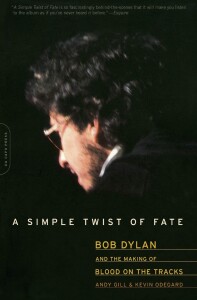 Bob Dylan’s Blood on the Tracks is a landmark album. It is listed on numerous “best-of” album lists, be they of “all time” or the Seventies, or of the rock era. It and its follow-up, Desire, are his two top-selling studio LPs. Some 3 million copies of it have been sold in various formats all around the world, including a 2003 reissue CD in the new hybrid/SACD format.
Bob Dylan’s Blood on the Tracks is a landmark album. It is listed on numerous “best-of” album lists, be they of “all time” or the Seventies, or of the rock era. It and its follow-up, Desire, are his two top-selling studio LPs. Some 3 million copies of it have been sold in various formats all around the world, including a 2003 reissue CD in the new hybrid/SACD format.
The album’s success was all the more remarkable in that it was unlooked-for. Dylan’s output had been spotty since a near-fatal motorcycle accident in 1966, after which he had holed up at his home in Woodstock, N.Y., with his wife, Sara. In eight years, he put out some intriguing country-leaning albums, a cover album, a live album, and had moved from his longtime label, Columbia, to Geffen. His live appearances were limited mostly to walk-ons, although some were definitive, such as his strong performance at George Harrison’s benefit concert for Bangladesh.
But in 1974, his restless spirit was beginning to reassert itself, and his marriage was on the rocks. Dylan is one of the most secretive of rock stars, so little has been revealed about this painful period of his life. But the songs that emerged from it to become *Blood on the Tracks* were on the one hand a “return to form” (that dreadful critics’ cliche) and something new. As Dylan had shown in 1966 that rock music could be a serious vehicle for the artistic portrayal of the complex emotions and concerns of youth, so once again Dylan was about to show that rock could contain and reflect the inner life and turmoil of an adult. Rock was about to grow up with its creators and its consumers.
A Simple Twist of Fate tells the story of the making of this watershed work. In language that is remarkably disciplined for a book about a major rock ‘n’ roll celebrity, Gill and Odegard lay out a tale that is surprisingly complex. And it’s a sad and sordid tale, indeed; perhaps not quite as shocking as the one documented by the 2003 film Standing in the Shadows of Motown about the anonymous house band behind dozens and dozens of the top soul and r & b hits of all time, but similar in the details.
Dylan recorded the entire album in about a week in a New York City studio in September 1974. The producer was Phil Ramone, and the band was called Deliverance, led by Eric Weissberg. The only musician credits on the album to this day are for Eric Weissberg and Deliverance. But when the album was released in January 1975, only one track, “Meet Me in the Morning,” featured that band; four others from those sessions featured just Dylan accompanying himself on guitar, or with one or two other musicians.
The rest were entirely re-recorded at a studio in Minneapolis, in two days near the end of December, with a group of local musicians, unknown outside the Twin Cities scene. They were assembled by Dylan’s brother, David Zimmerman, who was active as a promoter on the local level. The core group comprised local jazz players Bill Berg on drums and Billy Peterson on double bass, Chris Weber and Kevin Odegard on guitars and Gregg Inhofer on keyboards, although there were a handful of others involved, including fiddler Peter Ostroushko.
These Minneapolis musicians, particularly Berg and Peterson, did excellent work, as is evident to anyone listening to the album all these years later. And yet they’ve never been credited until now. The album sleeves had already been printed when Dylan re-recorded four of the key tracks in the Minneapolis studio, including the album-opening “Tangled Up in Blue” and the epic “Idiot Wind.”
Odegard was one of the musicians, and his involvement in the book casts a shadow on the project’s objectivity. But, although some of the musicians initially were upset when their names failed to appear on subsequent releases of the album, none of them holds a grudge enough to carp about it in the book except for Weber and his wife.
Gill and Odegard do a good job of setting the scene for the recording of both versions of the album. The book’s style is informal, journalistic, and anyone accustomed to reading music criticism will feel comfortable reading it. They deftly portray the action in the studios, and explain musical terminology when they use it. They also do a good job of explicating the lyrics of these complex songs — you may not agree with their analyses, but you’ll at least know where they’re coming from. They delve a bit too deeply into Freudian-style analysis of the relationship between David and Bobby Zimmerman, but that’s the sort of excess anyone who studies and writes about Dylan can hardly avoid.
A Simple Twist of Fate turns out to be anything but simple. The tale is a valuable addition to the reams and reams already published about Dylan’s life and music.
(Da Capo, 2004)
